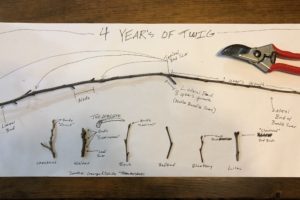The White-breasted Nuthatch is a climber, for sure. It had caught my eye scooting around on the large branches of the old Hackberry in our back yard. A hard summer thunderstorm had just passed through, and everything was drenched and getting beat on once again by the sun. Everything sparkled with a wet surface, and in the deeper shade of the Hemlocks were a few sunny spots where falling drops of water could be seen exploding on skinny dead branches. Up high again, the little nuthatch was working down hill, scouring the sharp ridges and skinny furrows of the warty Hackberry bark for spiders. The bird’s black, mullet-like cap and bright cheeks is easy to see even from a hundred feet away through a cheap pair of binoculars. There are plenty of mature trees in the backyard of our farmhouse and I guess that these specimens offer the natural economics that birds like the nuthatch thrive off of. The big trees themselves house hierarchies of species that support one another in many-if not all-ways. I imagine the large cavity in another old Hackberry-or the jagged, storm damaged hollow rim of another failed leader-could very well be the nesting site for the bird; or maybe it is the hollow in the Sugar Maple where a scaffold branch once grew, possibly torn off under a heavy ice load one winter; or an abandoned woodpecker hole up the hill a ways in a standing dead pine snag, riddled with the perfectly round bark beetle holes and cured to a muffled white that is not unlike the breast feathers of the nuthatch if the sun hits them right.
My son and I have been in the habit lately of dangling about on the same Hackberry. That same rough bark on the main stem had caught his fancy too, like a little bird. He was able to grab onto the big sharp ridges and hold himself tight to the trunk, a clear but subtle comfort that the old tree offers those who will take it. We even saw a spider racing around, surely doomed for a bird’s meal in the coming days, although I guess one could never be so sure in the wild where things are headed. The Hackberry bark eventually caught his tender elbow a little too hard as we were spinning about and left him with a little boo-boo, and a good reminder that with courage certainly comes consequences. I’ll let him decide their worth, as all wild things must do. But I know I am so happy it is this big old Hackberry that he wants to go way up into, especially after being cooped up inside waiting out the heavy, driving rains of late August and the receding tide of summer.
John Muir wrote that “when we try to pick out anything by itself, we find it hitched to everything else in the universe.” I like that thought because it is cohesive, or at least it encourages us to be cohesive in how we perceive the natural world that we work in. It’s hard not too, the nuthatch, the Hackberry, a little scrape on the elbow. There is no doubt a connection there with all of the plants and animals and trees. Unfortunately, my observations are just funny little glimpses around, a thoughtful glance up into the crown of a big tree.
But I find solace in the words Bernd Heinrich writes in his book The Trees in My Forest, “My casual observations provided no insights, just questions. I saved myself thousands of hours of potential work, yet found answers to some of these questions in just a couple of hours by reclining with reprints in one hand, and a cup of coffee in the other. There are times when it makes sense to be an armchair biologist, especially when one bumps into hundreds of questions and has only one lifetime in which to seek answers,” (178).
So then, in closing, under a late summer night, if tomorrow I wake to hear the nasal rattling of the nuthatch call from high up in the Hackberry, then I’ll know at least one thing is certain.





2 Comments
Leave your reply.